Compact Graflex Camera
Vintage1915 Postcard Camera
3¼ x5½ inch film or plate.
Manufactured
By Folmer & Schwing.
Graflex Compact 5x7 reflex camera
Travelling city postcard
photographer in the early 1900 's.
1915-1925
Focal Capacity 10 "
Kodak 3a Film 122
Curtain Aperture
Automatic Safety Curtain
Postcard Format
Flash back to the begin of the 20th century
In the year 1916 the Graflex Compact cost US $ 70,00 without lens and $120,00 including
a Bausch & Lomb Tessar
1-C lens.
The Tessar lens was manufactured by Bausch and Lomb under licence from Zeiss Germany
However these prices don't mean anything until you are aware about the average
earning in USA, back in 1915.
In 1913 income tax came on the scene. You were doing about average if you were
making $ 687 a year, according to the Census*
Public school teacher $ 507.00
City Ministers $ 1092,00
*) official survey of the population of a country in order to find out how many people live there and to obtain their age and job.
As cameras were expensive and not widely available in the early part of the last
century, families would often visit a local photographer studio to have their
photo taken.
These shots were turned into postcards so they could be sent to family and
friends.
The above photograph shows the Graflex 3 1/4 x5 1/2 inch Compact camera manufactured in
the early decades of the last century by W. Former and Swing.
This particular camera has been equipped with new made bellows to replace the old
worn one.
Why is it named Compact?
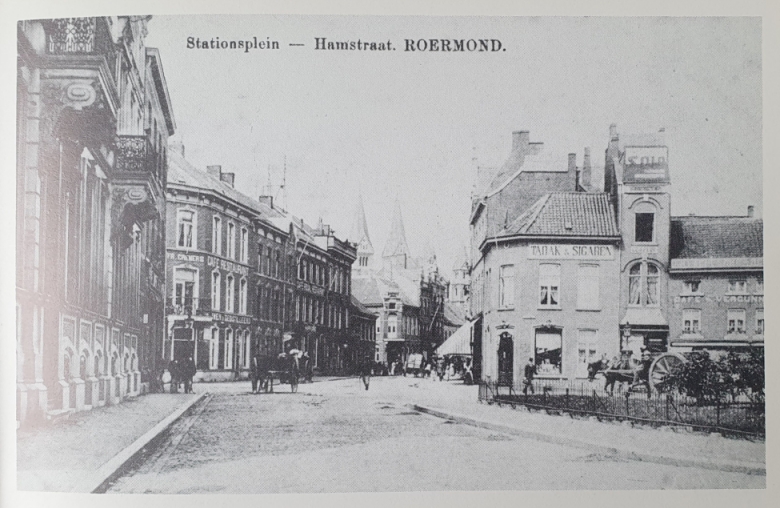
Example of such a city postcard photo of
the main street of my hometown some 100 years ago.
Want to explore the today's use of such a
camera?
This Graflex embodies many -for that time- new features and particular attention is directed to
the "new" automatic safety curtain.
This curtain is actuated by the swinging mirror frame, protecting the sensitive
layer on the plate or film for incoming light when the mirror is set.
As soon as the release lever is pressed the swinging mirror takes its place in
top of the exposure house and at the same time drops the safety
curtain to allow the focal plane shutter to make the exposure in the usual
way.
So there is no risk to blur your negative when setting the mirror for the next
exposure.
The dark slide is exclusively needed if the holder is taken down from the camera
back.
No need to slide it on/off if setting the mirror.
The mirror frame in this camera is constructed of aluminium, which reduces the
weight of the camera and as the mirror frame seats against an air cushion in the
top of the camera, it eliminates all danger of vibration,
which is a valuable feature when making slow exposures holding the camera in the
hand.
An improved mechanism was provided for setting the shutter for Time or
Instantaneous exposures and the improved shutter winding tension
is so constructed that all mechanism inside the plate is thoroughly protected.
However its successor had a square plate and improved Time release lever.
The focusing hood is made amply large to afford full view of the focusing screen
when making exposures with the camera held in position for making either
horizontal or vertical negatives.
This hood is made so that it detachable affording easy access to the focussing
screen. The lens board support is made out of metal and is fitted with a spring
actuated clamp which firmly grips the track at any desired point.
The Compact Graflex Camera is fitted with the regular Graflex Focal Plane
shutter permitting exposures of any duration from Time to 1/1000 second .
Two tripods sockets were provided, one in the base for horizontal and one in the
left side for vertical exposures.
The back of this Compact Graflex camera was constructed to take the
postcard film pack holder. More about that here below.
Convertible Zeiss Protar Lens F:6.3 - F:7.7
Bausch & Lomb - Zeiss Protar Series
VII focus 11 3/16
Rear lens cell Protar Series VII focus
11 3/16
Directions for Operating
Open camera and focusing.
1) Release catch near centre of camera to open the top cover.
2) Raise the cover which automatically extends the focussing hood.
3) Press down the two side arms which will draw the focussing hood taut and hold
it rigidly in position.
4) Open front of the camera by pressing the release lever R.
5) Pull the drop bed down until it locks itself.
6) Squeeze the spring actuated clamp of the lens standard and pull the lens standard to
the infinity mark on the
track of the drop bed.
7) Adjust fine focus with rack and pinion on right side of the drop bed.
8) Turn diaphragm to adjust wide open and less open aperture and check the
effects on the ground glass.
9) Enjoy focusing on near by and far away objects and practice opening and
closing the drop bed.
Having said that, you know or at least would soon find out, that there is no postcard size film on
the market anymore.
The manufacturing of the 3 1/4 x 5 1/2 format has been discontinued in the 20th
of the last century.
However there are two possibilities to try out to take pictures with this fine
classic camera.
There are still
3 1/4 x 5 1/5 roll film holders
to be found on eBay. However, as
said before, unfortunately no appropriate film.
The good news is that there are film adaptor kits for sale on eBay to enlarge
your 120 film spool to the larger size of the old 124 Kodak Film
which was the appropriate film for the Graflex Compact 3 1/4 x 5 1/2
camera. In other words, the normal available 120 film spool, gets an adapter on
both sides to fits
between the spool reception mechanic of the camera.
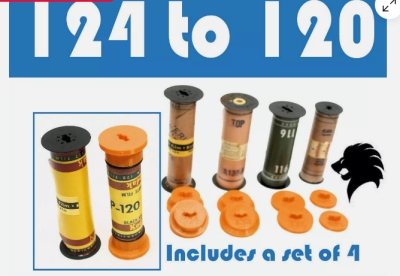
Another option is to use the old Postcard sized film pack holder. This holder
was used with the no more available 3x5 film pack.
These holders are often to find on eBay and mostly very low priced.
No need to alter this film pack holder. Just a block of wood or plastic with the
size of the inside hinged cover of the Film Pack Holder to serve as
a filler and light baffle as well.
It fills the gap between the back of the sheet of film film and the cover of the
holder and closes the slit of the holder light tight.
You only have to cut down the 4x5 sheet film to 3 1/4 5 inch and place it with
the sensitive side to the front with the darkslide.
Place the block on top of the sheet film back and close the hinged cover.
Unnecessary to tell that loading the holder with film has to be done in fully
darkness.

Setting the mirror for focusing and exposure
oval top plate with mirror control, winding mechanism, I - T setting plus
T release lever.
Pull the lever H backwards until the mirror locks in focusing position.
This position, with the mirror on 45 degree, allows a view on the ground glass
to focus on the subject.
The shutter contains 5 apertures or slits ranging from full opening to 1/8 of an
inch. When the letter O appears in window F,
the shutter is wide open.
The other apertures 1½, 3/4, 3/8, and 1/8 follow in rotation visible in window F
as the winding key is turned to the left.
The plate mounted to the viewing hood shows the curtain aperture.
The combination of curtain open slits and tension of the focal plane shutter -
visible in numbers on the lower plate window G -
results in the obtainable shutter speeds.
Preparing the settings for Instant exposure
The calculator table on back of the focussing viewing hood will help you to
choose the exposure time setting.
Nowadays we can use an electronic exposure meter rather than guessing.
Press down lever H into the mirror focusing position
Set bar beneath disk on I = instant
by sliding the bar D to the left to its utmost position.
" I " appears left from
the disk.
Now wind the curtain by turning the key to the left, until the required number
appears in the window F.
If the curtain is set at a smaller aperture than required, release the curtain
by pressing the lever M downward until the proper aperture is registered at
window F.
Note: as the first Compacts were not equiped with a long lever,
operation is not easy. You may like testing this procedure several times.
Note: A safety lock prevents the rewinding of the curtain before the mirror
is set in focusing position. This prevents fogging the film
making it necessary to set the mirror before rewinding the shutter curtain.

Now we move our attention to the lower plate.
Here we're going to set the spring tension of the focal plane shutter.
The spring tension is needed to draw the curtain with the previous programmed
slit, down along the film surface.
To achieve this, turn the milled tension knob B on the lower plate
anticlockwise until the appropriate number appears in
the window.
The tension numbers can be set from 1 to 6
If the previous setting appears to be too fast, the tension can be released by
sliding the escapement knob P upwards.
Each move reduces the speed one number. Check the setting again and if they are
correct, the camera is ready for taking photo's.
Place the film holder
slide dark slide in open position
Now the shutter has been set and the image on the ground glass is properly
focused, the exposure is made by one gentle downward pressure of the release
lever
which is located on the forward, left hand side of the camera body.
This pressure on the release lever simultaneously releases the mirror and the
safety curtain.
Once the safety curtain is pulled down, the focal plane shutter including its
previous set slit, starts its trip along the film to expose.
Slow instantaneous exposures of about 1/5 second can be made with the curtain
set at O (full opening) and tension number on 1.
Pressure upon the shutter release causes the mirror to rise just before the
curtain with the slit drops, closing the exposure aperture.
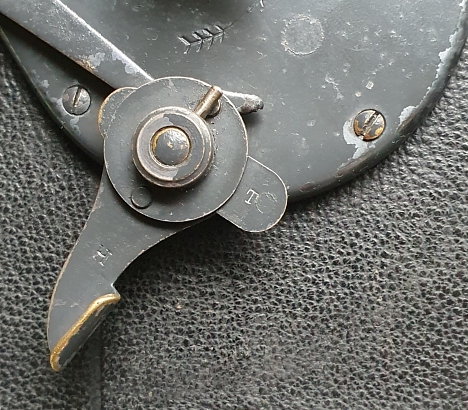
Time Exposures
To push the bellows and lens back into the camera
Hold lever H backwards
Pull back the mirror lever H
Before storage, the camera
should be closed and the bellows
and lens should find its place inside the camera's mirror house.
To achieve this, the mirror should be kept back in its utmost back position even behind
the exposure setting.
Now squeeze the lens standard lock and push the lens standard inwards the
camera house as far as possible.
Release the lens standard lock to fix this position before closing the drop bed.
Press side brackets to fold the drop bed till it locks in the snap lock.
By moving the protruding lever H
backwards the mirror is rocked in one direction and held in a 45 degree position. The mirror projects in
this operative position the image on the ground glass.
Operating the exposure knob, the mirror frame
5 flies upward and closes the focusing aperture and seals the
exposure chamber from the entrance of light from the ground glass.
The arrival of the mirror frame in closed position pulls down the safety
curtain. Now the film exposure frame is set free, the exposure curtain starts
its travel along the film surface.
The pre-set opening slit together with the pre-set curtain speed tension,
exposes the film as it should be.
Some more interesting technical details
The bellows storage system.
US Patent 932,457 William F. Former.
Drawing shows clearly the slant position of the frame (7) of the
partly stretched bellows.
Fig 1
1 indicates the camera body, the detachable back has been removed.
2 The exposure chamber
3 The bed
4 The extension bed.
5 The adjustable front.
6 The bellows
7 The tilting bellows frame pivoted to 8
8 pivoted frame which when tilted back to an erect position, makes room within
the body for housing the front.
At the top of the exposing chamber (2) there is a focusing opening 9 surrounded
by a focusing hood and fitted ground glass.
Part Two
Renewing Bellows

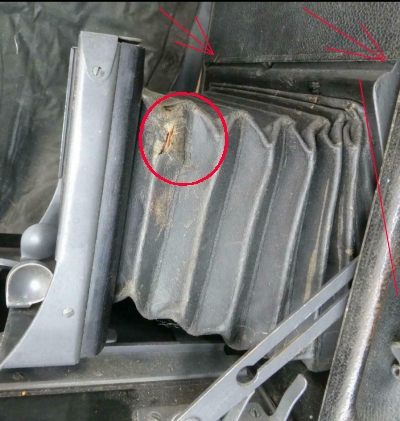
by pulling out the lens board as far as possible the bellows may show its imperfections.
Before working on the camera, remove the focussing hood and ground glass.
Cover the
mirror to protect its silver sensitive surface coating.
Never rub such a mirror. Cleaning only with a nylon static dust cleaner.
To start disassembling separate the bellows including inside front plate from the back of the lens board.
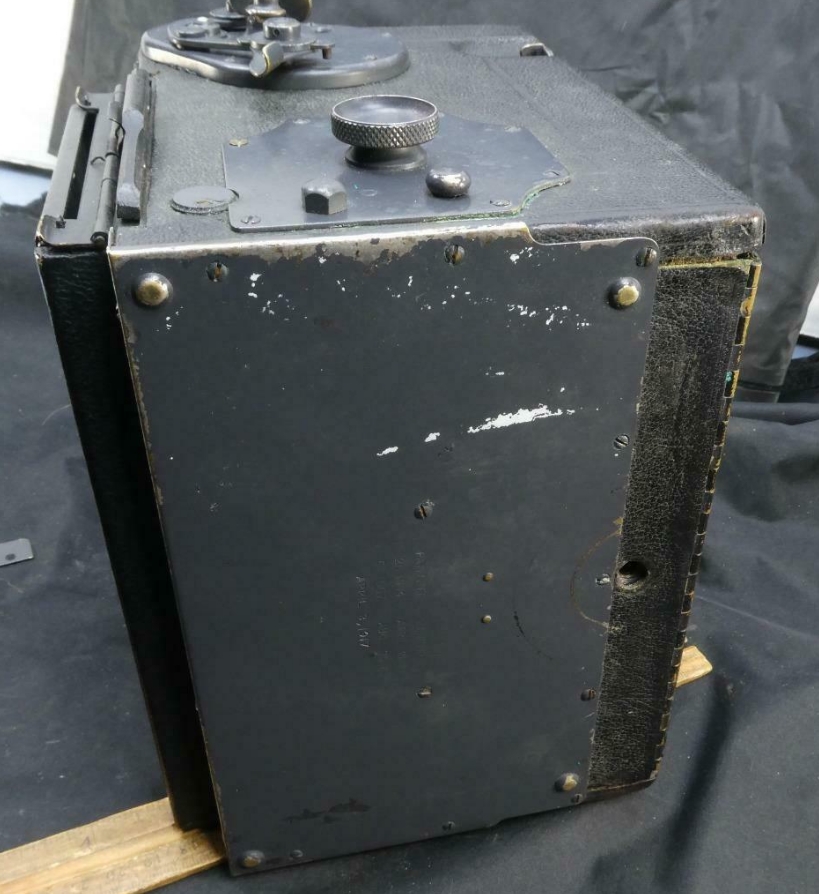
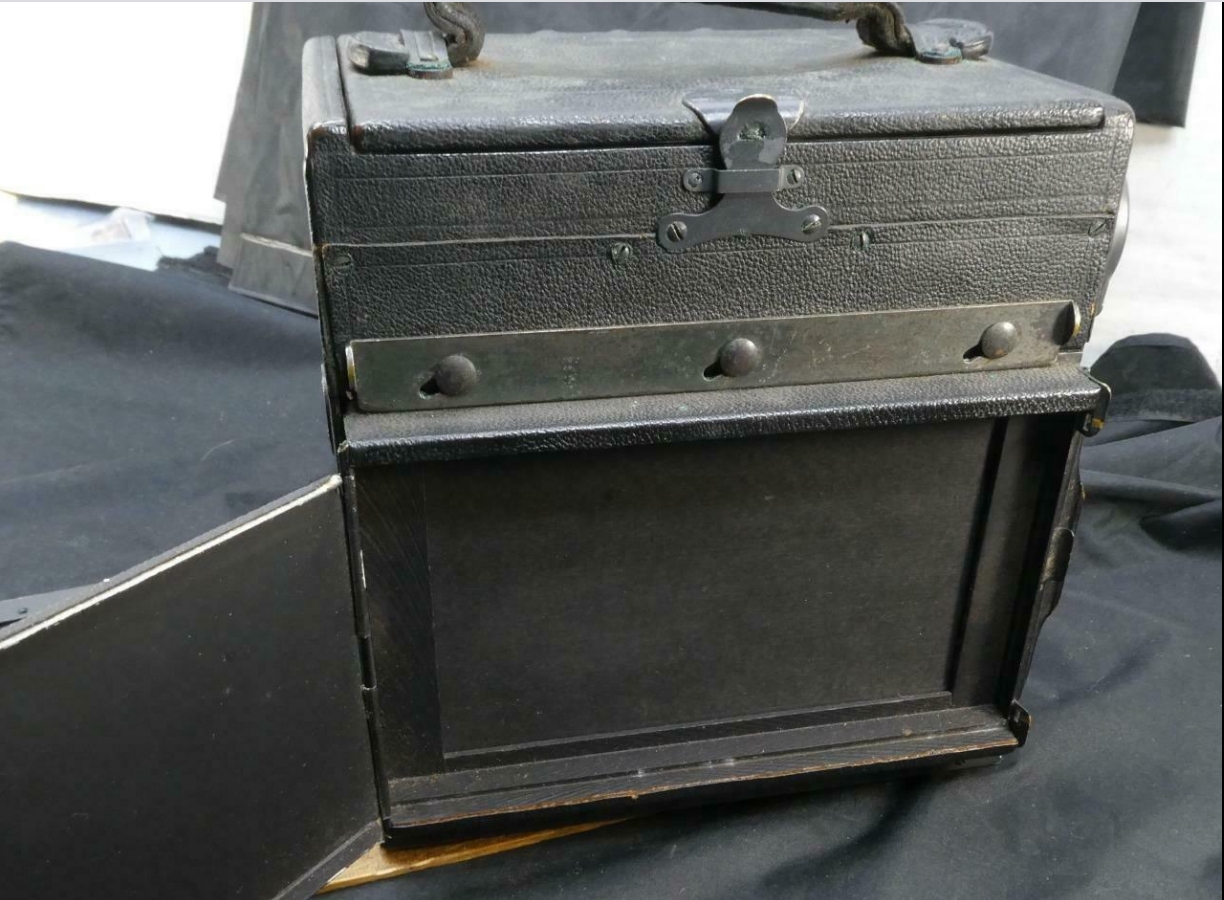
Photo on the right: Backside with film holder. Don't remove
film holder to avoid touching the focal plane shutter or use a cardboard
protector shield.
Make sure the mirror is in horizontal position.
Start inspection of the camera before beginning to
disassemble.
Note the grey plate cover protecting the mirror setting assembly shown on the
left photo.
Right photo. Check the working of the focal plane shutter. Unlike most of the
Graflex focal plane shutters, this one is equipped with a third blind which
raises
while the mirror is set in focussing position and thus at the same time protecting light coming into
the exposure chamber.
Now
the normal curtain setting by key winding can be done without the need of
the dark slide.
Check the working of this.
New Bellows for the Graflex Compact Camera
Remove old worn Bellows
Start the work by removing the old worn bellows.
To remove the lens including the lens board unscrew the top plate of the lens
standard and slide the lensboard including the lens upwards out of the standard.
Store the lens on a save place.
Remove the infinity screw on front of the track and pull out the lens standard.
The outer board is coupled with the board inside the bellows.
Separate them by carefully bending the little hooks holding the inner lens
board. The inner lens board can be taken off now.
If you bend the hooks too much they might brake off, so you better bend just
enough to be able to get the outer board separated.
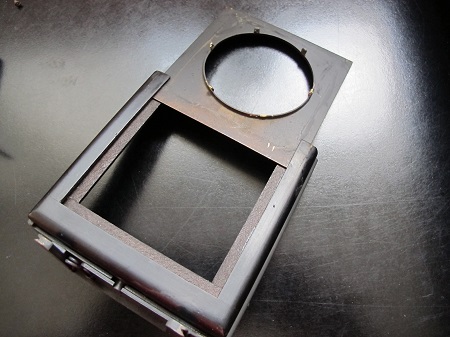
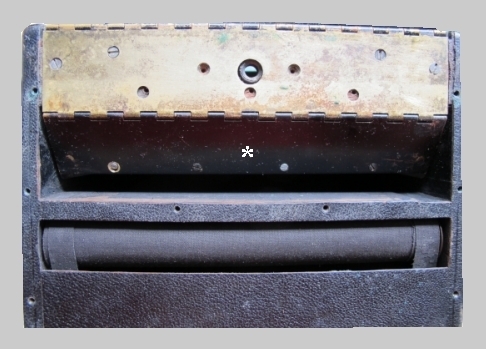
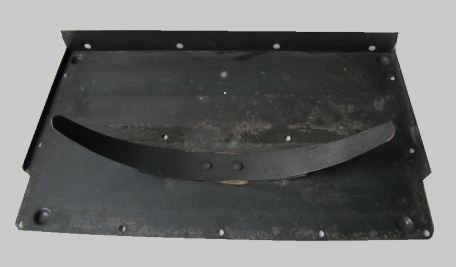
The left picture shows the Compact Camera inside with removed bottom plate.
Picture on the right side shows the plate with blade spring.
The star* marked hinged plate holds the bellows frame
under spring tension.
This bottom plate is equiped with a blade spring which keeps the bellows frame -
mounted on black hinged plate - in
its position.
While unscrewing the screws of the bottom plate keep the plate with one hand
tied to the camera to avoid damage to the screw holes in the wooden camera body
as well as flying screws in your work place.
After removing the bottom plate, The brass hinged plate becomes visible.
6 more screws are waiting to be unscrewed but make notes and keep the screws
separated.
No need to dismount the hinged drop bed.
From now on the inner bellows assembly is free to be removed out of the camera
housing.
The left photo shows the partly disassembled camera bottom.
After completely taken down the bottom assembly, you'll be able to pull out the
bellows frame including the worn bellows including the inner part of
the front lens board.
To achieve that, fold the bellows together as much as possible
and slip this package through the slit in the bottom.
The advantage of this procedure is that the front of the camera is open now and
you'll be able to tinker with both hands to get the whole package safely out of the
camera.
While disassembling, please pay attention to store the screws separately and make notes
and take photos of
their original location. Each part of this assembly has its own screw size. It is
very important to put them back on their original location.
The bellows inside the camera house is fastened to a wooden frame by nails and you have to be very
careful getting the little nails out without breaking the frame.
Be aware that you won't find those very tiny nails in your local hardware shop
nor in your surrounding world, so you'd better try to get them out of the frame
without spoiling them.
The separated bellows is very useful for
taking the measurement to create the new bellows. Take length measurement of the
four folds and
length and width of the frame and inner lens board. Make a dummy out of
thin cardboard for testing purposes.
Making New Bellows.
The slant shaped bellows are not easy to design and manufacture.
First make a paper or cardboard dummy to check if the old bellows fits around it
and if the slant back fits precisely into the bellows frame.
Use Photo Shop® or Coral Draw® to design the bellows folds. Print them on normal print paper
and glue them to the dummy cardboard design. (right picture below)
9 mm for each stiffener, 2 mm for the space between them and so on.
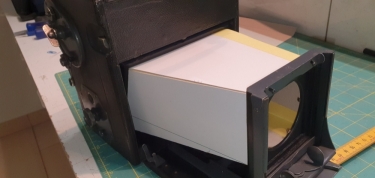

cut out the space between the stiffeners and make sure to use
removable tape to consolidate their position.

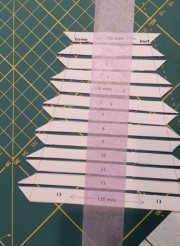
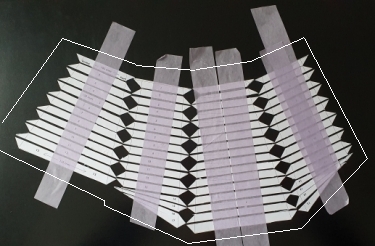
If the drawings are ready cut two pieces of fabric out of the BK5 Black Nylon fabric.
One piece for the outside and one for the inside cover. Take at least one inch more
than your pattern.
Only use spray glue and and glue the stiffeners to the BK5-Black Nylon Blackout fabric.
You should end up with a round closed model which needs to be formed with your
fingers to the bellows.
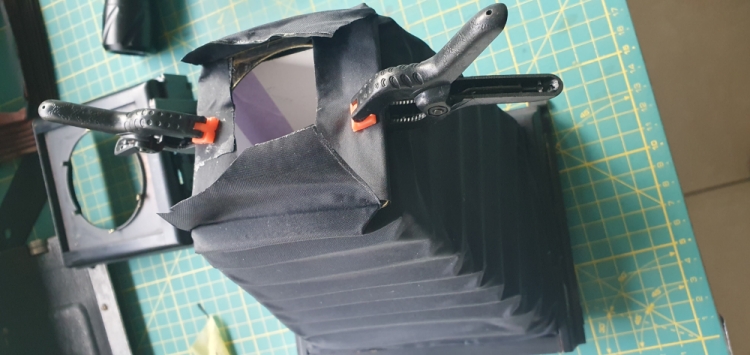
Mount
the inner lens board into the front of the bellows.
I used the test cardboard dummy to
hold the new bellows strait while working on it.
Mount the back of the bellows to the frame using the original tiny nails.

I'm really happy to
present the overhauled 1917 Compact Graflex in perfect working condition
and equiped with new bellows.
Camera Photos © Jo Lommen